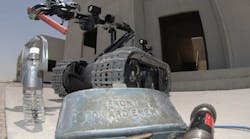A research team competing in the Tough Robotics Challenge presents a lightweight, high-power artificial muscle that could be used in robots performing heavy-duty tasks in disaster environments. The Challenge is part of the Impulsing Paradigm Change through disruptive Technologies Program (ImPACT), which is an initiative of the Japanese Cabinet Office Council for Science, Technology and Innovation. The research team includes Professor Koichi Suzumori from the Tokyo Institute of Technology and Dr. Ryo Sakurai from Bridgestone Corporation.
Lightweight and powerful, the artificial muscles are controlled hydraulically, and feature a flexible design comprised of a rubber tube surrounded by a woven high-tensile fiber sleeve. The strength-to-weight ratio is 5 to 10 times greater than conventional electric motors and hydraulic cylinders. The video below shows testing of a few flexible actuators on a 3-axis wrist. It also includes demonstrations of its robustness.
Classified as a type of McKibben artificial muscle, their unique end design enables them to work under pressures as high as 5 MPa—more than ten times higher than allowed by regular McKibben muscles. The higher pressure rating generates higher power for tasks like clearing out fallen rocks.
The artificial muscles' resistance to shock and vibration make them suitable for high-impact and dangerous environments, holding them to the requirements of the competition. While the proprietary end types allow them to actuate under very high pressures, they still demonstrate good controllability to enable gentle handling when needed. Their low weight reduces the burden of the load without compromising their power.


